Showing top 0 results 0 results found
Showing top 0 results 0 results found

Does your overall marketing strategy drive you in the right direction?
Are you and your marketing team doing the job right?
To answer these two simple yet essential questions, you need to confront your performance with your company's goals. After all, it all requires measuring major key performance indicators.
All right, but what does the term key performance indicator exactly mean? And what are the right key performance indicators for marketing?
Let's start at the beginning.
Key Performance Indicators Definition
Key performance indicators (KPIs) are specific metrics that validate everything what you do as a (marketing) professional. KPIs estimate results for separate teams and the business as a whole.
Therefore, if you strive to deliver long-term business goals at your organization, make sure marketing and sales teams have predefined KPIs and target them consistently.
Roughly, there are 30 metrics you should be tracking, while running or being part of an online business. Although not all KPIs go directly to marketing (they matter most for sales), they all are bound to each other.
So what are the most Important KPIs for marketing managers?
1. Sales Revenue
It's not breaking news. Let's face it. Marketing campaigns affect the entire sales funnel. And, at the end of the day, sales revenue becomes the primary concern of your leadership.
Sales revenue growth is crucial for any business. Frankly, it's what makes or breaks your company. Sales revenue should be continuously growing to be seen as healthy.
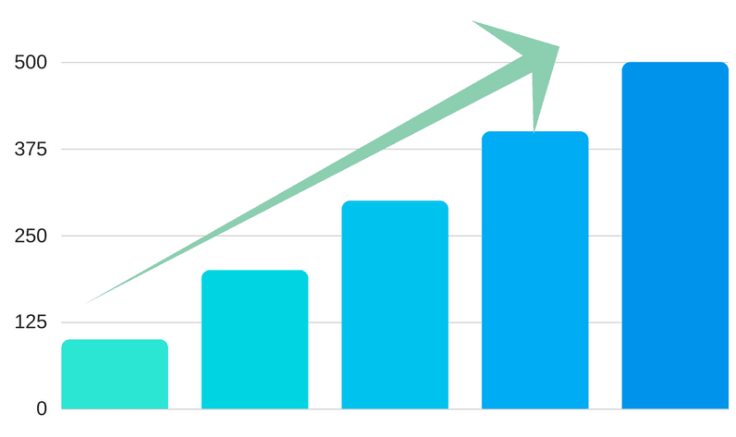
What can you do to make your coworkers care more about sales revenue? Be transparent and share the numbers with your team. Let people know what the current level of sales revenue is, what the expectations are, and how their work contributes to these results. It will boost the general motivation and efficiency of your coworkers, so it's worth-doing.
And, most importantly, make sure that all your marketing activities contribute to sales growth. Otherwise, you are wasting time and effort on pointless campaigns.
Remember Mark Zuckerberg's idea validator? Apparently, Mark always confronts up and coming concepts with one simple question Does this help us grow? That works as a warrant for further investments. Start asking the same question at your organization.
2. Number of Leads
A job well done, in marketing, is a job that unleashes the traffic storm to your website. And we don't mean garbage traffic though. We're talking about well-targeted and high-converting traffic. Obviously, the more leads your marketing campaigns generate the better. Because leads mean more revenue. And revenue means more profit(most of the time).
Become our partner
Build your business on excellent customer service products

But wait: What is a lead? Or rather, → who is a lead?
Typically, a lead is an individual, who filled out your on-site form (with more information than just a good old email address) in exchange for your content offer.
As you can see below, leads are located in the middle-top levels of the marketing and sales funnel. You should be able to distinguish two types of qualified leads. They're tightly bound to the funnel and goal completion.
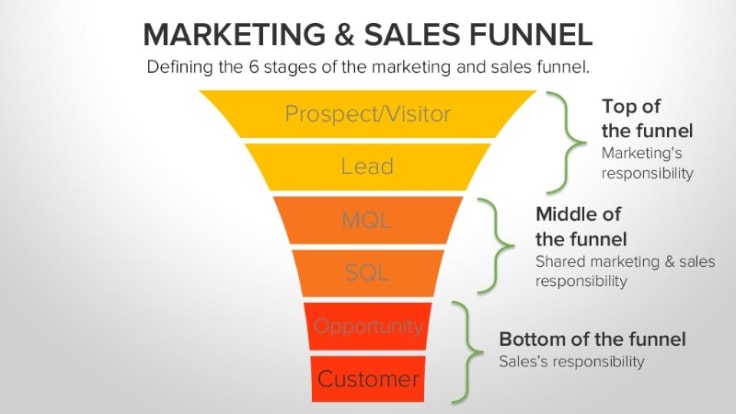
Marketing qualified lead (MQL)
Marketing qualified lead (MQL) is an individual who has raised his hands and identified herself as deeply engaged in your content and product. MQL might have requested a demo, downloaded your guide or got hooked on any other high-interest level offer. (Proving to be sales-ready.)
Sales qualified lead (SQL)
SQL is located right under MQL deeper in your sales funnel. This guy is an MQL defined by your sales team as follow-up worthy.
So, as you can see, there is a distinct difference between these two guys.
3. Cost per Lead
Another essential key performance indicator each marketing team should be confronted with is cost per lead. Especially, if you deploy paid campaigns because, for instance, content marketing is more cost effective.
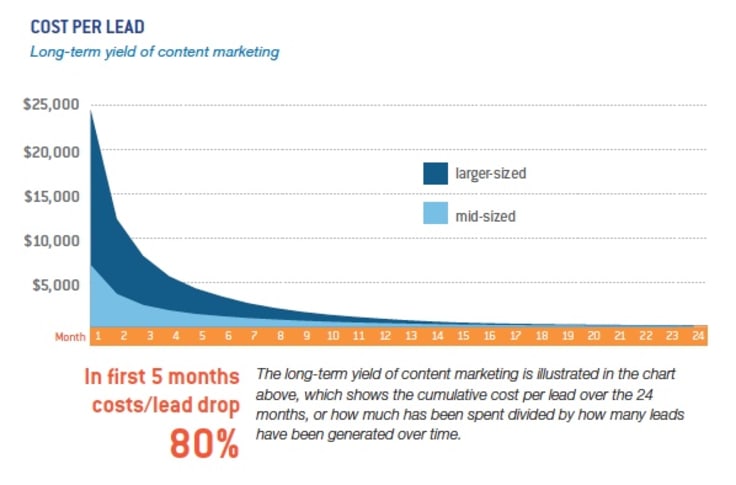
Cost per lead estimates how effective your marketing campaigns are. The purpose of this metric is to help your marketing team understand how much money should be spent on acquiring new leads.
Let's do some simple math to illustrate cost per lead calculation. For instance, you utilize pay-per-click (PPC) campaigns at your company. You spent $1,000 on a given ppc campaign, and as a result, 10 users converted to leads. In this case, cost per lead is $1,000/10 and this amounts to $100.
The rule of thumb is that your CPL shouldn't be to high in relation to your product's price. The more expensive your product gets, the higher CPL tolerance.
Also, CPL should be included in any ROI calculation.
With a cost per lead, your ultimate goal is to make it as low as possible. Once your campaign drives nice levels of traffic (and leads) while your CPL is small, you can consider it a great shot.
4. Cost of Customer Acquisition (COCA)
What is your COCA? Your average cost of client acquisition is an important metric to track.
To define this number, you need to collect all the company expenses and investments over a year or any other consistent time frame. Expenses, in this case, should include all marketing, sales, and business development costs you cover.
Once you have that number before your eyes, divide it by the number of new coming customers during that period.
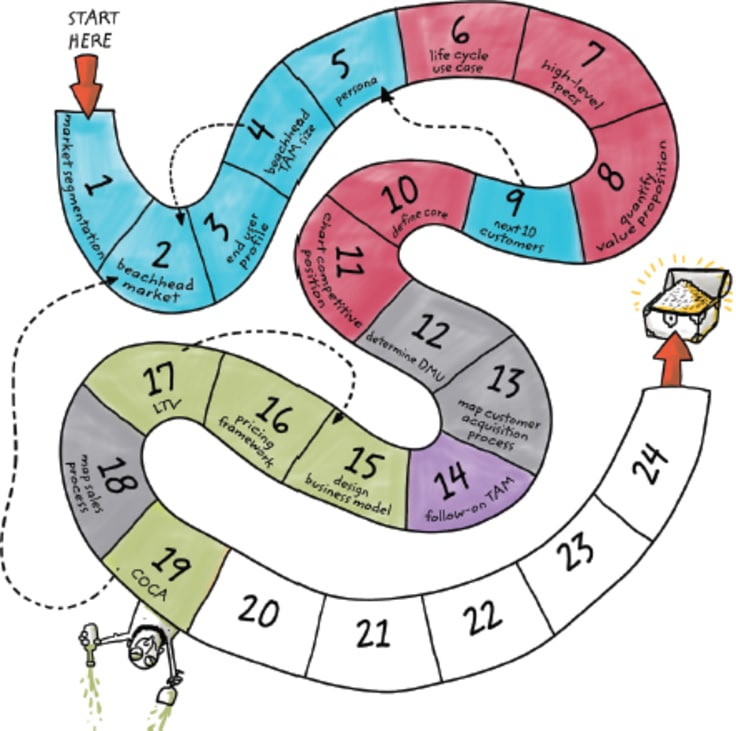
And voila.
Here is your cost of customer acquisition.
Let's say, all your expenses made up $500,000 last year and your company managed to acquire 5,000 customers in this period. Then your COCA equals $500. The cost of each acquired customer is $500. Now ask yourself. Is the COCA from my example worth the effort? Well, it depends on your customer lifetime value.
Over-investing or under-investing in each customer is a common mistake among early-stage startups. Therefore, keep track of your company's COCA and make sure you aren't falling into this trap.
5. Customer Lifetime Value (CLV)
In marketing, customer lifetime value (or CLV) is the value of a given customer reflecting his contribution to your business. Roughly, CLV is the projected revenue that a customer generates in a lifetime.
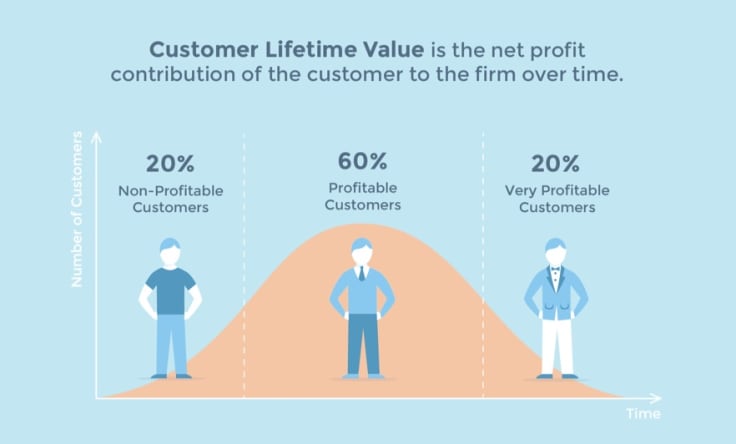
It determines the net profit attributed to the entire future relationship with your customers. And gives you a perspective on where to invest your resources and what customers are the most valuable to you.
Customer lifetime value is one of the metrics that matter most for the present and future success of your e-commerce business.
And you actually can't afford to ignore it. Without knowing your customers' value, you simply won't have any idea where to head next. It's like losing your orientation in the woods with no compass to help.
Read more about CLV in my latest article What is Customer Lifetime Value and Why You Should Care.
6. Marketing ROI
Marketing ROI (MROI) is, well, what the name implies.
It's a way to measure revenue generated on top of the investment. In this case, it's the amount of money spent on marketing. MROI defines how much money returns to your wallet once you invest into some marketing campaigns and implement a given strategy.

It can be used in a broad or narrow scope. MROI covers overall marketing expenses versus returns or the performance of a single campaign in the given period.
Quick ROI check (for KPI planning)
As you define KPI targets for campaigns and channels, model outcomes with our marketing ROI calculator.
- Enter ad spend, revenue, and costs per channel
- See ROI, payback period, and break-even instantly
- Compare scenarios to set realistic KPI targets and budgets
There are several benefits of using this measurement at your organization:
7. Traffic to Lead Ratio
How many website visitors do you need to get one lead?
Traffic to lead ratio is your conversion rate put differently. This metric is a ratio of website visitors who leave your site without completing any goal versus your leads in a given timeframe.
Traffic to lead ratio measures your ability to capture leads. This is heavily dependent on website design, user experience, and the quality of your content. Let's say you have 1,000 website visits and 100 new-coming leads per month. This means your traffic to lead ratio is 10:1, or a 10% conversion rate.
8. Lead to Customer Ratio
We can throw a similar question here:
How many leads do you need to get one customer?
That's the next, higher level of conversion. This metric illustrates the relation between your leads and customers in a given timeframe. Let's say that your lead to customer conversion rate is 2%. It means you need 200 leads to get 2 customers.
9. Organic Traffic
Matt Southern
Building organic traffic is the hardest work you'll ever put into your website. With that being said, it's also the greatest investment of time and effort you can make.
High-visibility and massive organic traffic coming to your site is every entrepreneur's dream. If you ask me why, then I'll tell you because it's the best traffic for your business. It's a free and stable stream of website visitors. However, building it isn't a quick task to do.
This traffic source deals directly with SEO. Content you put online today will drive organic traffic tomorrow, the day after tomorrow, next month and probably several years from now.
The better your ranking for competitive keywords is, the higher levels of organic traffic you get to your site. Organic traffic grows over time as a result of successful marketing in search engines and expanding brand awareness.
You'll say that paid traffic tends to be of higher quality. You'll be right. But paid traffic is not sustainable, since it doesn't last forever. It's only a temporary solution that works only as long as you invest in PPC. So you can't neglect organic traffic in favor of PPC.
Want to use organic traffic to evaluate your online marketing initiatives? Then you track your results over long-term intervals to see the improvements over time.
Back to you
There is much more to talk about regarding marketing key performance indicators. This is enough for one lesson, let's pause for a while and try to review and digest what you've learned today.
- Sales Revenue
- Marketing Qualified Leads (MQL)
- Sales Qualified Leads (SQL)
- Cost Per Lead (CPL)
- Cost of Customer Acquisition (COCA)
- Customer Lifetime Value (CLT)
- Return on Investment (ROI)
- Traffic to Lead
- Lead to Customer
- Organic Traffic
Whoa. It's been a long day today. Hope you understand the importance and calculation of these several key performance indicators mentioned in this article. Go back to work and make sure you put real numbers on whatever you can. Does your overall marketing strategy drive you in the right direction? Are you and your marketing team doing the job right? Do you know the answers now?
Want to talk about this topic some more?
Grow with us
Find new revenue streams for your business.

Happy marketing!


